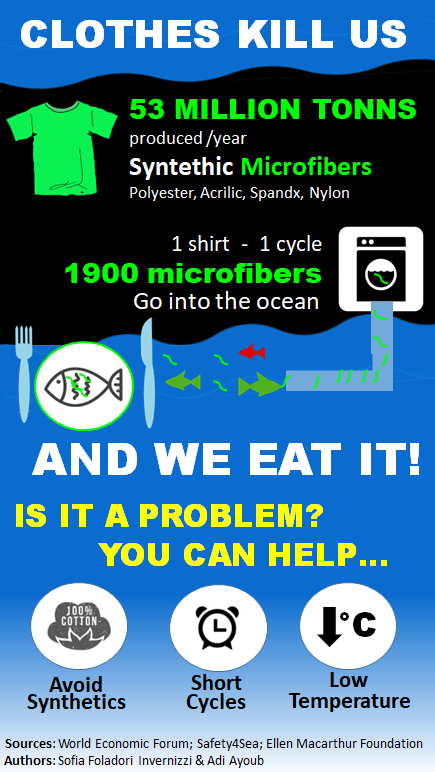Microfibers in clothes
Clothes production is big, and the use of synthetic fibers like polyester, acrylic, spandex, and nylon is increasing. These fibers, specifically small pieces in microscale eg. Microfibers, can be released during washing cycles. This process allows the fibers to be transported into oceans, rivers, and lakes, as they cannot be easily filtered. Once in the water, they enter the food chain and consequently come into our plates when we consume fish and seafood.
However, some alternatives could help mitigate this issue, like increasing the use of natural fibers in clothing, using shorter machine cycles for washing, and washing at low temperatures.
Objective
Organize the information regarding the liberation of synthetic microfibers from clothes during a washing-machine cycle, and the possible consequences and mitigations
Workflow
The information regarding microfibers was systemized in PowerPoint to produce a simple infographic
Results

References
Some of the references were recently updated
Chaker, A., & Jensen, M. S. (2022). Plastic pollution is a public health crisis. How do we reduce plastic waste? World Economic Forum. https://www.weforum.org/agenda/2022/07/plastic-pollution-ocean-circular-economy/
Ellen MacArthur Foundation. (n.d.). Redesigning the future of fashion. Ellen MacArthur Foundation. https://ellenmacarthurfoundation.org/topics/fashion/overview
McFall-Johnsen, M. (2020). These facts show how unsustainable the fashion industry is. World Economic Forum. https://www.weforum.org/agenda/2020/01/fashion-industry-carbon-unsustainable-environment-pollution/
Myers, J. (2022). Microplastics in the food chain: How harmful are they? World Economic Forum. https://www.weforum.org/agenda/2022/06/how-microplastics-get-into-the-food-chain/
Safety4sea. (2021). Study finds polyester fibers in the Arctic Ocean. Safety4sea. https://safety4sea.com/study-finds-polyester-fibres-in-the-arctic-ocean/
